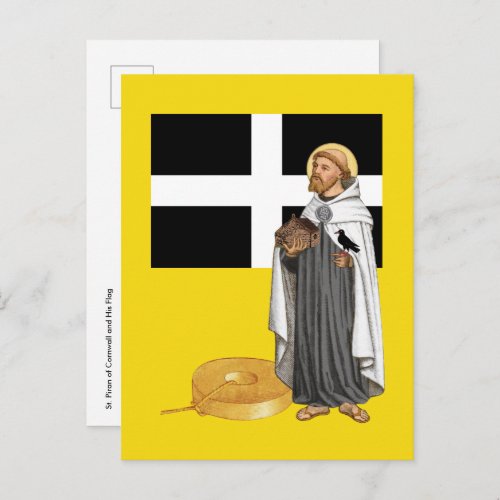St. Piran of Cornwall (SAE 01) and His Flag Card



In the Early Middle Ages, Ireland was the source of many missionaries. Perhaps no Irish monk set out for his mission in a more dramatic fashion than St. Piran (Peran in Cornish; d. 480): He was thrown off a cliff in the middle of a storm with a millstone tied round his neck. Already somewhat advanced in years and with a well-deserved reputation for healing, St. Piran had incurred the jealousy of the local Irish chieftains. He did not die according to plan, however. Tradition tells us that the millstone popped up like a cork, acted as a raft, and St. Piran floated on it safely to the coast of Cornwall, England. Upon disembarking at Perran Beach, he made his first converts: a bear, a badger, and a fox. He built an oratory nearby which is, perhaps, still “the oldest place of Christian worship in England with its four walls still standing”. And, he established the Abbey of Lanpiran and several other churches, chapels, and holy wells. St. Piran died at his Oratory of natural causes on 5 March 480. + Here, St. Piran is clad in monk's robes and stands against a backdrop of his Flag. + The figure of St. Piran is a pastiche of elements—a hand here, another hand there, etc.--primarily drawn from various Pustet devotional prints grafted onto the base figure of St. Simon Stock. St. Piran’s Oratory held in his right hand is derived from a 19th-century engraving; the chough (or palores in Cornish) perched on his left hand, from heraldry. His brooch is patterned after an Irish altar stone. + St. Piran is patron saint of tin miners and--by extension--miners in general. Tin was mined in Cornwall in remote antiquity, but smelting techniques were lost during the recession that accompanied the Roman withdrawal from Britain in the early 5th century. According to tradition, it was St. Piran (d. 480) who rediscovered tin smelting when the molten metal rose to the top of his hot hearthstone forming a whitish cross. A white cross on a sable black field became the design of St. Piran’s Flag. + St. Piran’s Flag (or Baner Peran in Cornish) is flown on Cornish holidays especially on March 5 (St. Piran’s Day), at most Cornish and Cornish-descent gatherings as well as sporting events with Cornish teams. It has also been adapted for everything from lapel pins to bumper stickers. Our golden yellow background derives from the gold coins on the shield of the Duchy of Cornwall. Black, white, and gold constitute the Cornish color scheme. + Image Credit (SAE 01): A Saints_Aplenty Exclusive. + Image Credit (St. Piran’s Flag): Public Domain, Wikimedia Commons.


